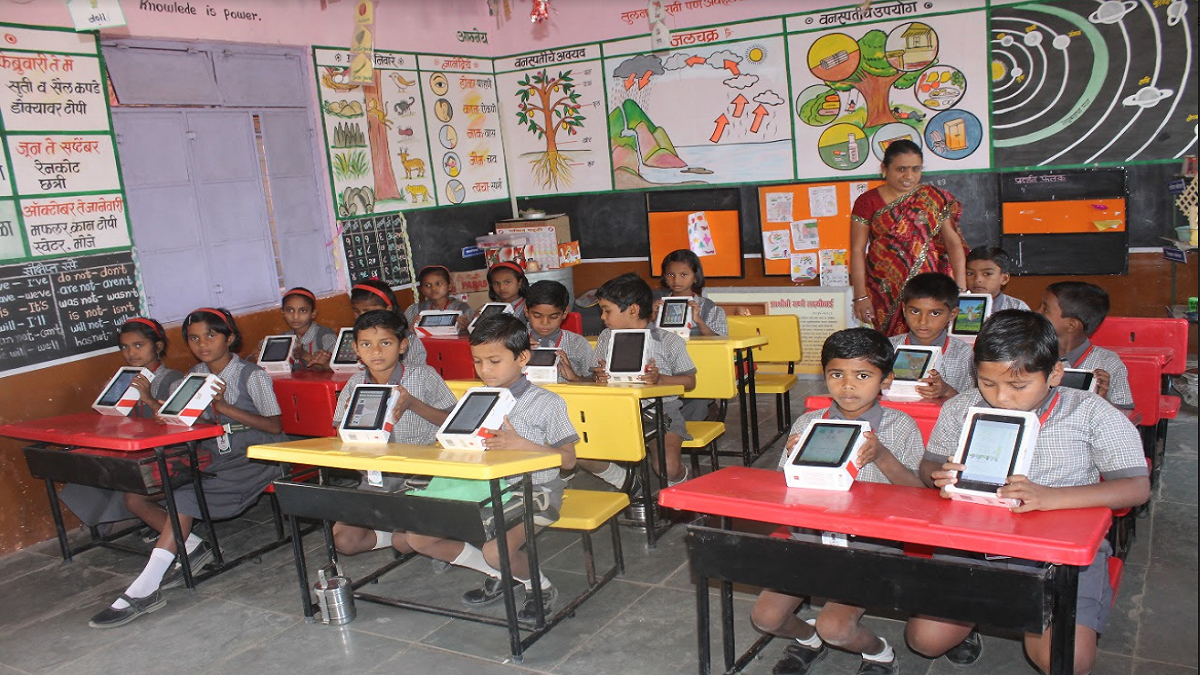


I had travelled to more than 20 states during the initial months of by stint as Secretary, School Education and Literacy, Government of India during 2016-17. It was heartening to see some fabulous work being done in the hinterland in the context of school education. However, what I witnessed as I walked into this Zila Parishad school in a village called Pashtepada was incredible. The proud teacher, Sandeep Gund had received me and he took me around the school that was now totally digital even in the absence of regular electricity supply.
Pashtepada is a small hamlet, situated 40 km from the block headquarters at Shahapur and 80 km from the district headquarters at Thane, Maharashtra. Sandeep Gund got his first posting in this village, with a population of 350, as a Zila Parishad primary teacher. The village was hard to reach as the last bus halt was in a village 2 km away. Still, the teacher was eager to start his work. When he reached his destination, he saw a neglected school building and barely 50% attendance of the enrolled children. Neither children nor the parents expected much from the school and its teachers. But Gund was optimistic and had bright dreams for his students.
Noticing that the children were fascinated by the screens and moving images, Gund decided to use the computer as a learning tool. He got an old computer as donation from an NGO, the first digital tool in this school. Experimenting on a computer he developed simple learning lessons, screened films, and made PPTs to show to the children. A TV set like device attracted children to the school.
Gund succeeded in achieving complete attendance with this first step. The students in Pashtepada were free from schoolbags. Each child has a tablet with pdf textbooks and references uploaded on them.
Tablets were also used as recording devices to record lectures, classroom activities and answers by students in their own voices.
The school was wellequipped with digital devices like interactive smart boards, infrared camera, interactive projector, interactive monitor, e-desk, and epodium, and it also had digital content library with wi-fi connectivity accessible to students. All these systems ran on solar energy, with a one-time investment of INR 1.25 lakh. The solar unit was portable, as the panels were foldable. Once charged the school devices could run for 5-6 hours.
The upgradation took place gradually as it was dependent on availability of funds. The primary support for this came from the community through cash donation and labour. They were joined by a few NGOs and other donors.
As I took a selfie with Sandeep Gund and tweeted , he suddenly got noticed at the national level. Later, when I had the occasion to meet the President of India in a different context, I narrated this wonderful story to him and asked him if he would like to meet Sandeep Gund. The meeting did take place when Gund was accorded a national award. Sandeep became a national hero and his model came to be replicated in more than 50,000 schools of Maharashtra. It was this experience of witnessing good work in a remote location, the impact of its appreciation and recognition and, finally its scaling led to the idea of Nexus of Good.
To begin with there was just a Twitter handle but now it is evolving as a movement to bring around people to identify, understand, appreciate, replicate and scale good work that is being done in the society as a whole. The idea is to evolve an alternative narrative to the negativity that is becoming all pervasive in the social media and other mediums of communication. Such negativity is impacting thoughts and actions of a large number of people, especially the young minds.
There is no doubt that a lot of good work is happening around us but unfortunately, on account of all pervasive negativity, it gets lost. The “premium” on good work seems to have been lost in the din of the high decibels used for promoting negativity
The “good” are struggling for recognition and a number of them are fighting their battles against a much more organised set of “negative mongers” all alone. Can the good work in tandem? Should the good work in tandem? Is it possible to convey the benefits of positive thinking and good work?
The idea is not to discuss ideas. The objective is to ideate from a practice that has worked on the ground. The aim is not merely to appreciate this good work which indeed is the initial step, it is to explore the potential of replicating and scaling this practice. It also to foster public-private partnership because the belief is that quality usually comes from the private domain and scale from public. There a number of such examples. Likes of Kaivalya Foundation, Akshara Foundation, Sampark Foundation, Akshay Patra, Lend a Hand and Humana People to People are demonstrating that good work can be replicated and scaled through public-private partnership.
There are also a large number of individuals like Sandeep Gund, around. We need to locate them, understand what they have done and how they have done it and then attempt to replicate and scale these practices. That is what Nexus of Good all about. The movement has already got going with hundreds of positive stories on the portal nexusofgood. org, most of them set to be replicated and scaled.
Anil Swarup has served as the head of the Project Monitoring Group, which is currently under the Prime Minister’s Office. He has also served as Secretary, Ministry of School Education and Secretary, Ministry of Power.